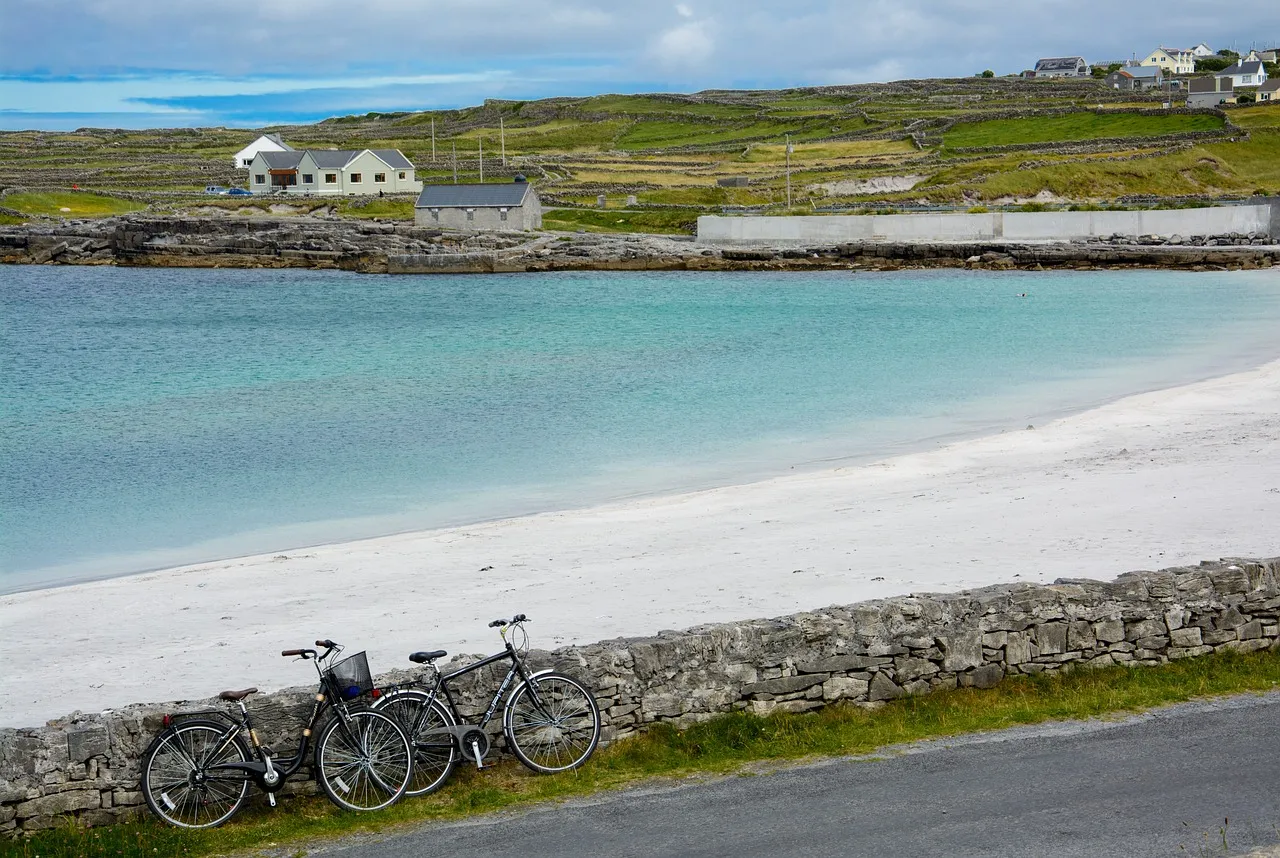Introduction: Where Time Slows and Tradition Breathes
Step off the ferry or the tiny island-hopping plane onto the Aran Islands, and you step into a different world. Floating at the mouth of Galway Bay, 48km (30 miles) from the mainland, Inis Mór, Inis Meáin, and Inis Oírr – the Big Island, Middle Island, and East Island – are Ireland’s westernmost outposts before the vast expanse of the Atlantic reaches for America. This isn't just mainland Ireland transplanted offshore; it's a place apart, where the very landscape dictates a unique way of life, and the echoes of ancient history resonate in the salty air. Forget the rush of modern life; here, time seems to stretch and slow, offering a sanctuary, a glimpse into an older Ireland that modernity hasn't entirely smoothed away.
The first thing that strikes you is the landscape – stark, dramatic, and utterly captivating. These islands are geological siblings of the Burren in County Clare, extensions of its unique karst limestone terrain. Vast pavements of grey rock, fissured with deep cracks known as 'grykes' separated by flat slabs called 'clints', stretch across the islands. There's little natural topsoil; for centuries, islanders painstakingly created fertile patches by layering seaweed and sand gathered from the shore, nurturing life from the bare rock. Protecting this precious, man-made soil is an intricate lacework of dry-stone walls, thousands upon thousands of miles of them, crisscrossing the fields in patterns that are as practical as they are picturesque. On the southern and western edges, dramatic cliffs plunge hundreds of feet into the churning Atlantic, while the northern shores offer more sheltered coves and surprising sandy beaches. Amidst this seemingly harsh environment, an extraordinary array of plant life thrives, with Arctic, Mediterranean, and Alpine species growing side-by-side in the sheltered grykes and thin soils, a testament to the islands' unique microclimate.
This challenging yet beautiful environment hasn't just shaped the scenery; it has profoundly shaped the culture. The very act of survival – coaxing crops from thin soil, navigating the wild Atlantic in traditional tarred-canvas currachs for fishing, finding warmth and clothing from the resources at hand – fostered a resilient, self-sufficient spirit and a unique set of traditions. The world-renowned Aran sweater, with its intricate, meaningful stitches, wasn't born as a fashion item, but as essential, durable workwear crafted from sheep's wool. Building and maintaining the endless stone walls became a specialised craft. The landscape isn't merely a backdrop here; it’s woven into the fabric of Aran life, a constant presence that has shaped everything from farming techniques to folklore.
Crucially, the Aran Islands are a Gaeltacht – a region where the Irish language (Gaeilge) is not just preserved, but is the living, breathing language of daily life. While islanders are typically bilingual and switch easily to English for visitors, you'll hear Gaeilge spoken in the shops, pubs, and along the lanes – often in the distinctive Connaught dialect. This linguistic heritage is perhaps the most vital thread connecting the islands to their ancient past. Their relative isolation, particularly during periods when English influence was spreading rapidly on the mainland, allowed the language and its associated culture – traditional music, song (like the unique sean-nós singing), dance, and storytelling – to flourish with particular strength. Visiting the Aran Islands, therefore, offers more than just stunning views; it's an opportunity to connect with the deep roots of Gaelic culture in one of its most vibrant heartlands. Prepare to be enchanted by the unique atmosphere – serene, sometimes wild, always welcoming – of these extraordinary Atlantic isles.
Reaching the Islands: Your Journey Across the Bay
Getting to the Aran Islands is an adventure in itself, a transition across the waters of Galway Bay that separates island time from mainland time. You have three main options: ferries from Rossaveal in County Galway, seasonal ferries from Doolin in County Clare, or a short, scenic flight from Connemara Airport. Whichever you choose, booking your passage in advance is highly recommended, especially during the peak summer months (April-October), as services fill up quickly. Remember, the ferries are for foot passengers only; cars must be left on the mainland.
Setting Sail from Rossaveal (Co. Galway)
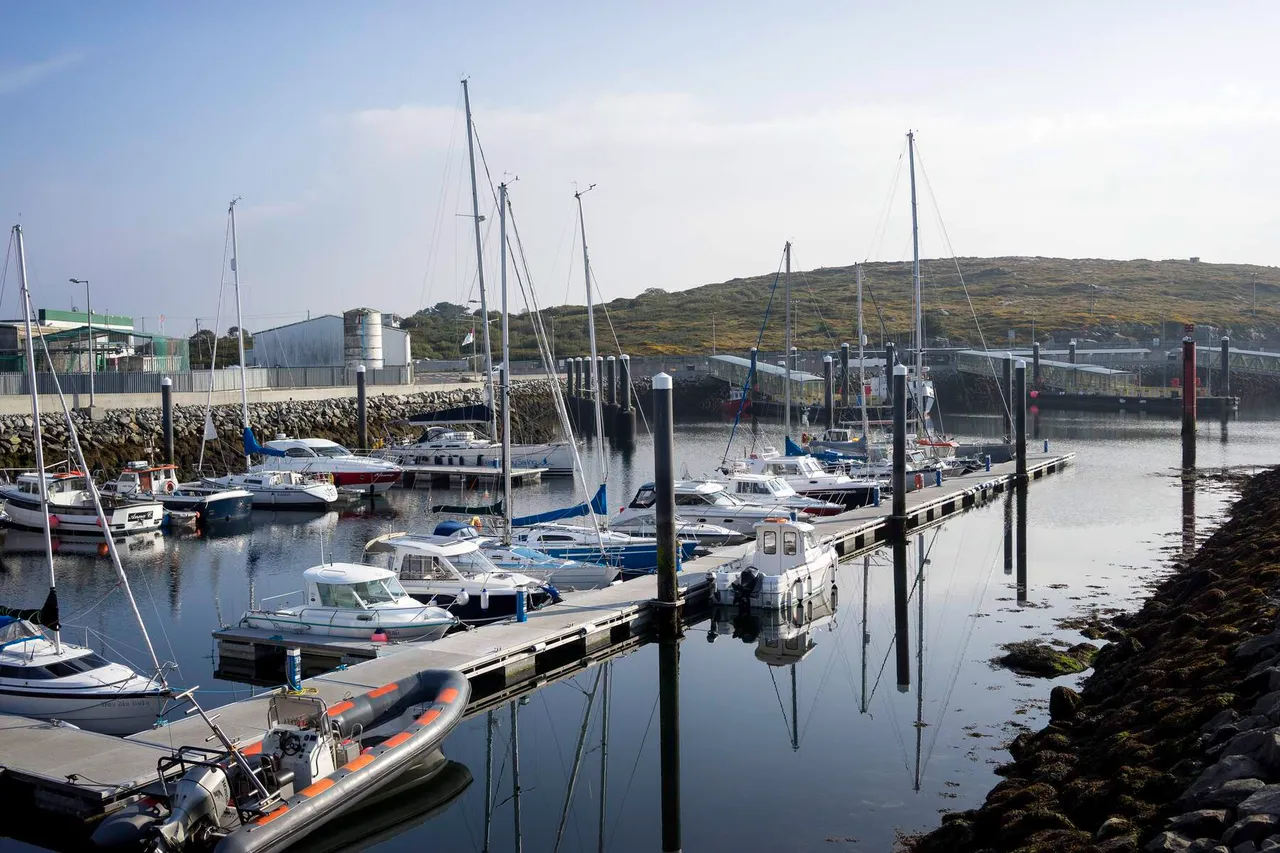
For year-round reliability and the fastest ferry crossing to Inis Mór, Aran Island Ferries operating from Rossaveal is the primary choice.
- Provider: Aran Island Ferries.
- Service: Operates all year to Inis Mór, Inis Meáin, and Inis Oírr.
- Location: Rossaveal Harbour (Ros an Mhíl), a port nestled in the Connemara Gaeltacht, approximately 37km (23 miles) west of Galway City. If you don't have your own transport, a dedicated shuttle bus runs from Victoria Place in Galway City centre to the ferry terminal for sailings; this must be booked in advance. Parking is available at Rossaveal pier for a daily fee (around €7 per 24 hours).
- Duration: The crossing takes approximately 40 minutes to Inis Mór, 50 minutes to Inis Meáin, and 55 minutes to Inis Oírr. Passengers can enjoy refreshments and bar facilities on board.
- Booking & Timetables: Tickets (around €34 adult return, with concessions available – check the website for current pricing) can be booked online via the Aran Island Ferries booking page. Detailed timetables are available for Inis Mór, Inis Meáin, and Inis Oírr. You can also arrange to bring a standard manual bicycle for an additional fee, but space is limited and must be pre-booked. Note that bicycles cannot be carried on the shuttle bus. Irish Free Travel Pass holders can travel free from Rossaveal under specific conditions, but must collect physical tickets.
Crossing from Doolin (Co. Clare)
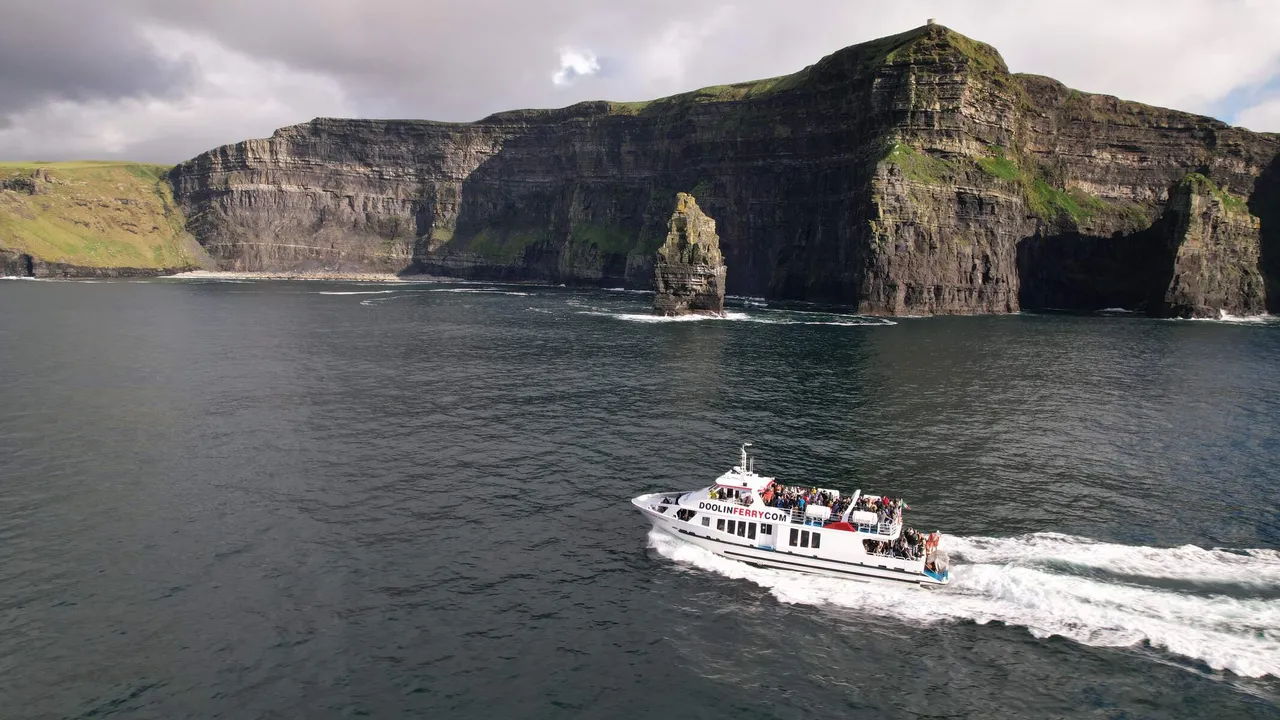
If you're exploring County Clare and the Cliffs of Moher, the ferries from Doolin offer a convenient, albeit seasonal, option, particularly for reaching Inis Oírr quickly.
- Providers: Two main companies operate from Doolin Pier: Doolin Ferry Co. and(https://obrienline.com/). Be sure which company you have booked with when arriving at the pier.
- Service: Typically runs from March/April through to October/November, serving all three islands. Sailings are more susceptible to weather conditions than the Rossaveal route.
- Location: Doolin Pier, located just outside the village of Doolin, famous for its traditional music scene and proximity to the Cliffs of Moher. Parking is available at the pier.
- Duration: Offers the fastest crossing times: direct to Inis Oírr takes only about 15 minutes, Inis Meáin around 25 minutes, and Inis Mór around 35 minutes. Be aware that some sailings, particularly later departures or those to Inis Mór/Inis Meáin, may involve stops at other islands en route.
- Booking & Timetables: Check the respective company websites for current schedules and fares (e.g., Doolin Ferry Co. adult return to Inis Mór approx. €39, Inis Oírr approx. €32). Online booking is available via the Doolin Ferry Co. booking page and(https://obrienline.com/). Timetables can be found on the Doolin Ferry Co. website. Many operators offer popular combination tickets that include a cruise beneath the Cliffs of Moher on the return journey.
Flying High: The Aerial Route
For a truly unique perspective and the quickest journey, consider flying to the islands.
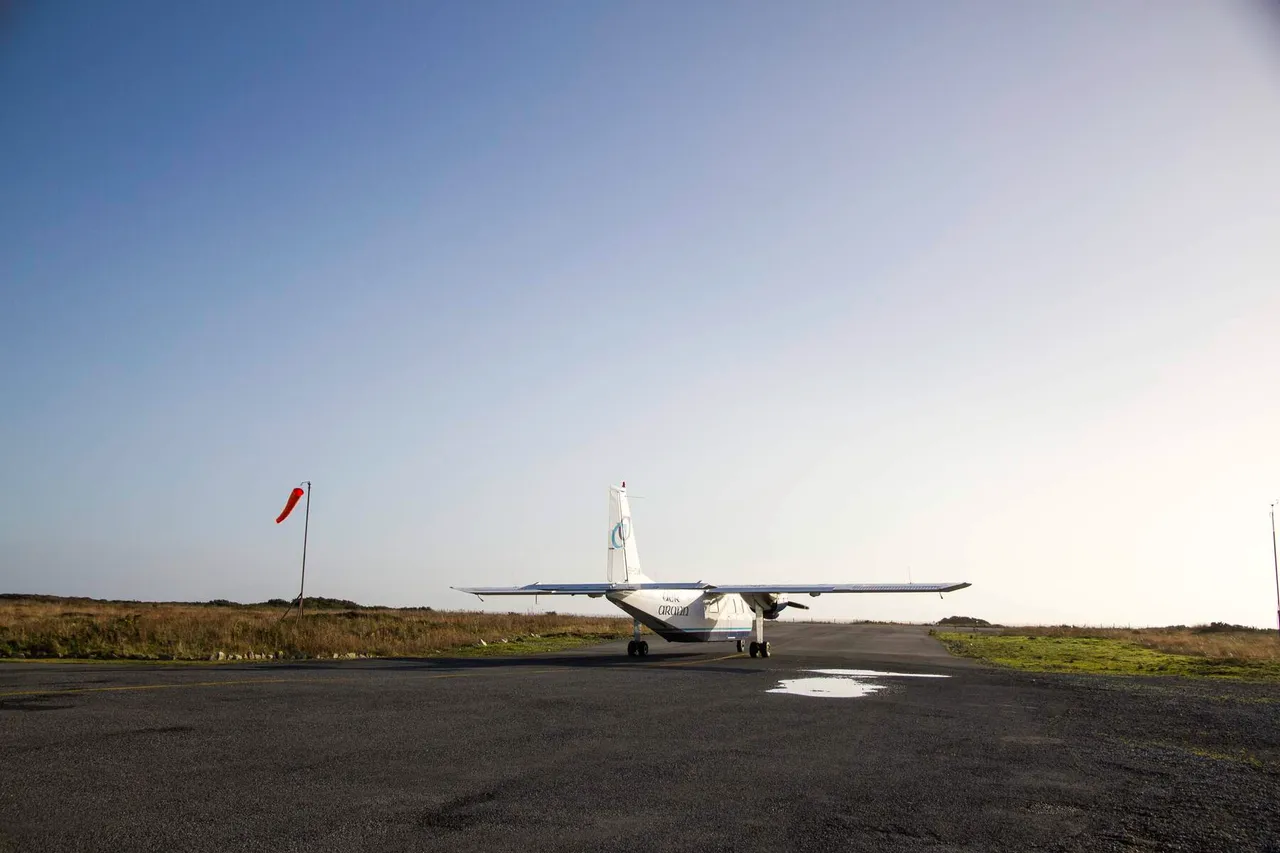
- Provider: Aer Arann Islands.
- Service: Operates year-round flights connecting Connemara Airport with the airstrips on Inis Mór, Inis Meáin, and Inis Oírr, though flights are weather dependent. The aircraft are small Britten-Norman Islanders, typically carrying just 9 passengers, offering an intimate flying experience.
- Location: Flights depart from Connemara Airport (Aerfort Chonamara - code NNR / EICA), located in Inverin (Indreabhán), Co. Galway, roughly a 40-minute drive west of Galway City. A shuttle bus service connecting the airport with Galway City (Victoria Hotel area) can often be arranged when booking flights.
- Duration: The flights are incredibly short – under 10 minutes to each island. The low altitude offers spectacular aerial views of the islands' unique stone-walled landscapes, cliffs, and the surrounding Galway Bay, weather permitting.
- Booking & Timetables: Flights should be booked well in advance, especially in summer. Current schedules and fares (approx. €63 adult return, check site for variations) are available on the(https://aerarannislands.ie/timetables-rates/). Bookings can be made via the Aer Arann Islands booking portal.
Island Hopping Notes
Fancy exploring more than one island? It's certainly possible and rewarding, as each island possesses its own distinct character. Both Aran Island Ferries (from Rossaveal) and the Doolin-based operators offer tickets that facilitate travel between the islands, though you'll need to check their specific schedules and booking options (Aran Island Ferries Inter-Island, Doolin Ferry Co. Inter-Island). Visiting multiple islands usually requires careful planning and often involves an overnight stay on one of them to make the logistics work comfortably. While Aer Arann serves all three islands, specific inter-island flight schedules may need direct confirmation.
The way you choose to reach the islands influences more than just your travel time. The year-round service from Rossaveal offers predictability but means travelling out into Connemara. Doolin provides quicker access, especially to Inis Oírr, and sits conveniently near the Cliffs of Moher, but its seasonal nature and smaller boats can mean greater susceptibility to cancellations in rough weather. Flying is the fastest, potentially most reliable in marginal sea conditions, and offers unforgettable views, but involves the unique experience of a very small aircraft and requires getting to the Connemara Airport. Consider your priorities – time, budget, season, tolerance for potential disruption, and desired experience – when making your choice.
Accessing the Aran Islands Summary
| Method | Departure Point | Provider(s) | Islands Served | Typical Duration (One Way) | Seasonality | Key Feature | Booking Link |
|---|---|---|---|---|---|---|---|
| Ferry | Rossaveal, Co. Galway | Aran Island Ferries | All three | 40-55 mins | Year-round | Reliable, fastest crossing to Inis Mór | (https://www.aranislandferries.com/booking) |
| Ferry | Doolin, Co. Clare | Doolin Ferry Co., O'Brien Line | All three | 15-35 mins | Seasonal | Fastest crossing to Inis Oírr, near Cliffs | (https://doolinferry.com/book-aran-island-trips/),(https://obrienline.com/,(https://obrienline.com/)) |
| Flight | Connemara Airport (NNR) | Aer Arann Islands | All three | \< 10 mins | Year-round | Fastest travel, spectacular aerial views | (https://booking.aerarannislands.ie/) |
Exploring Inis Mór (Inishmore): The Great Island
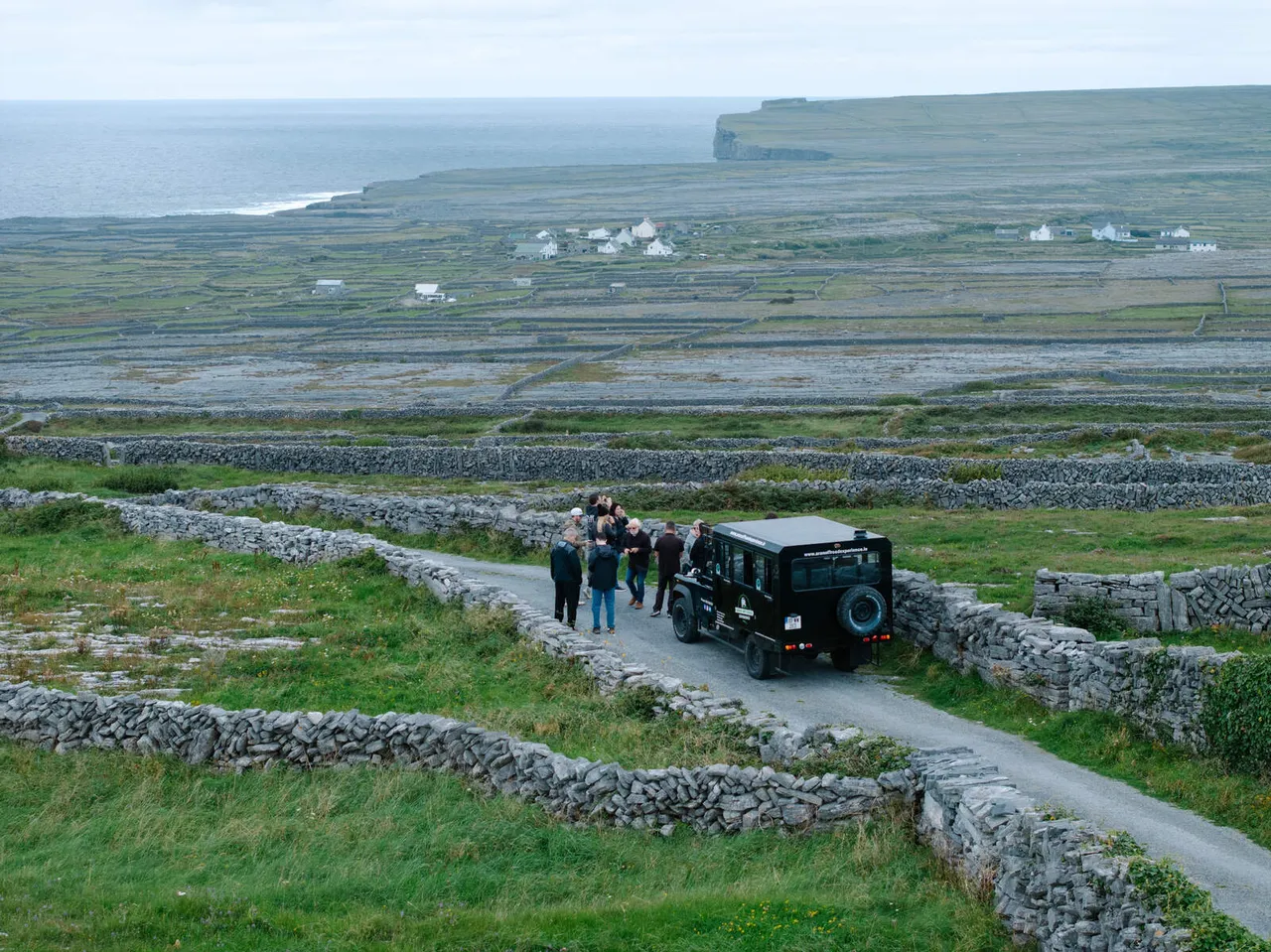
Inis Mór, true to its name, is the largest of the Aran Islands, stretching across 31 square kilometres of captivating limestone landscape. It's the most populated, with around 800 residents, and consequently the most visited, offering the widest range of facilities for travellers. Yet, despite its popularity, Inis Mór retains an undeniable authenticity, a feeling of being off the beaten path, where ancient history, vibrant Gaelic culture, and dramatic natural beauty converge. Its landscape is a tapestry of traditional stone cottages, the ubiquitous dry-stone walls segmenting surprisingly green fields, and rugged cliffs meeting the vast Atlantic. While it serves as the main hub, Inis Mór manages a unique balancing act, offering accessibility and amenities without sacrificing the essential Aran spirit. You can find bustle around the main village of Kilronan, but quiet corners and profound tranquility are never far away.
Ways to Wander: Getting Around Inis Mór
The scale of Inis Mór means you'll need some form of transport to appreciate its diverse sights fully.
- Bicycle Hire: This is the quintessential way to explore Inis Mór, allowing you freedom and immersion in the landscape.(https://www.aranbikehire.com/), conveniently located right by the pier in Kilronan, is the largest provider with a wide selection. You can rent standard mountain bikes (around €20 per day) or opt for electric bikes (around €40 per day), which come highly recommended for tackling the island's hills with ease. Tandems, children's bikes, child seats, tag-alongs, and buggies are also available, making it a great family option. Helmets and maps are provided, and they offer a breakdown service should you encounter any issues. Booking online, especially in summer, is advisable to secure your bikes. A popular route involves cycling the main inland road out towards the western end and returning via the flatter, scenic coastal road.
- Pony and Trap Tours: For a truly traditional and charming experience, step back in time with a pony and trap tour. These tours, often run by island families like Thomas Faherty's for generations, typically start from near the pier and last 3-4 hours. Your local jarvey (driver) will guide you along the lanes, sharing stories, history, and pointing out sights like Dún Aonghasa and the Seal Colony. It's a relaxed pace, perfect for photos and soaking in the atmosphere, and particularly appealing for families. Costs range from approximately €20 to €50 per person, and it's wise to have cash, as cards may not always be accepted. Custom tours can sometimes be arranged.
- Minibus Tours: If you prefer comfort or have limited time, guided minibus tours are readily available as you disembark the ferry. Local drivers provide commentary, covering the major historical sites and scenic spots efficiently. Companies like(https://www.discoverireland.ie/galway/aran-celtic-bus-tours-inishmore) offer these services.
- Walking: While Inis Mór is the largest island, walking is still a rewarding way to explore, especially for shorter distances or if you have plenty of time. There are three main waymarked loop trails: Lúb Dún Eochla (Green Trail, 10km, approx. 3 hours), Lúb an Chorrúch (Blue Trail, 12km, approx. 3.5 hours), and Lúb Chill Mhuirbhigh (Purple Trail, 16km, approx. 5-6 hours). These routes vary in difficulty but offer intimate encounters with the landscape. Shorter strolls around Kilronan village and along the nearby coast are also very pleasant. Be prepared for potentially uneven terrain near archaeological sites.
- Off-Road Tours: For a different perspective, the(https://www.discoverireland.ie/galway/aran-off-road-experience) uses a Land Rover Defender to access parts of the island other vehicles can't reach, promising unique Atlantic views.
Echoes of Ancients: Historic Sites
Inis Mór is rich in archaeological treasures, offering windows into millennia of human history.
Dún Aonghasa: Fort on the Edge of the World
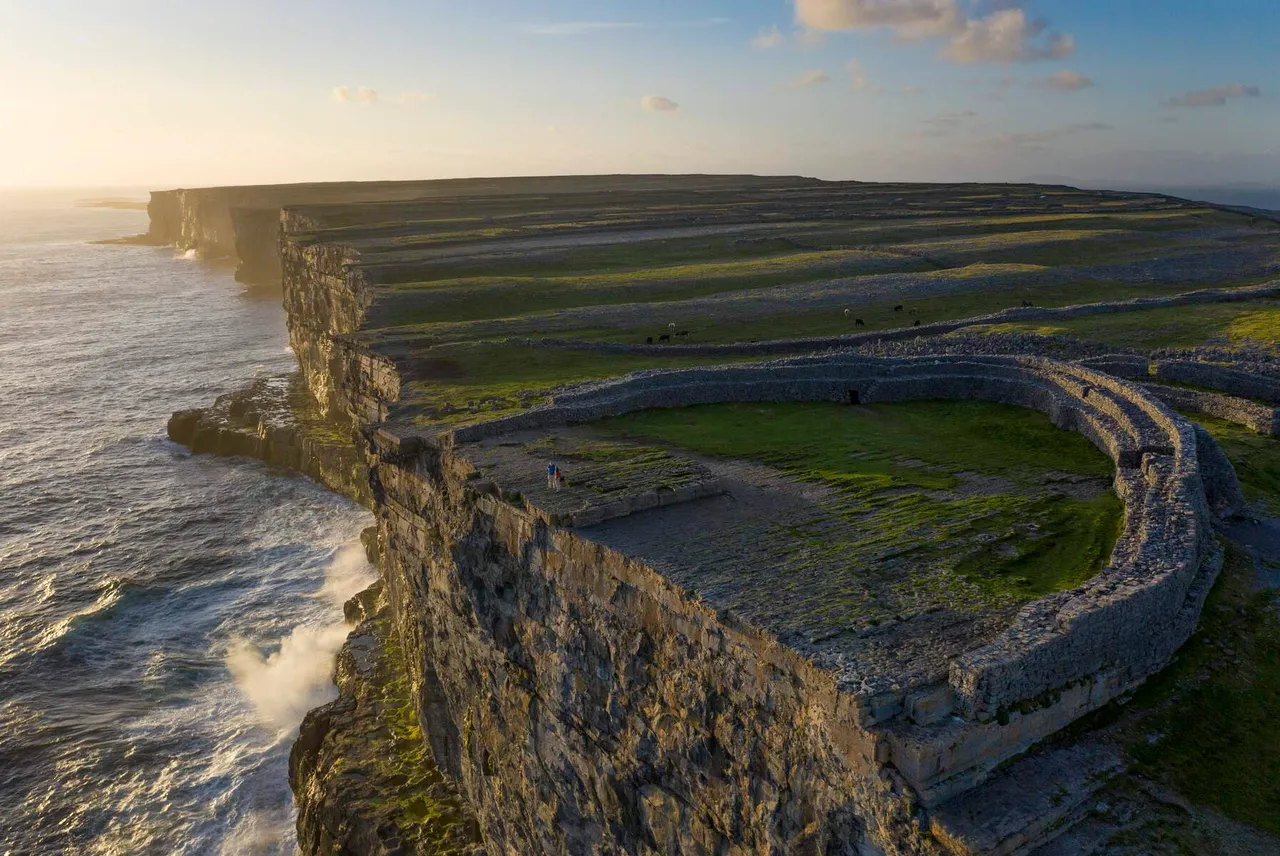
Undoubtedly the jewel in Inis Mór's archaeological crown, Dún Aonghasa (Dun Aengus) is one of Western Europe's most magnificent and dramatically situated prehistoric forts. Dating primarily from the Late Bronze Age and Iron Age (first enclosed around 1100 BC, with major activity around 800 BC), this vast semi-circular structure commands a breathtaking position atop sheer cliffs that drop 100 metres (330 feet) straight into the Atlantic. Covering 14 acres, its defences are formidable: three massive, concentric dry-stone walls curve back from the cliff edge, the outermost protected by a terrifying 'chevaux-de-frise' – a dense belt of sharp, jagged limestone pillars set upright in the ground to halt any attackers. Excavations revealed evidence of occupation spanning over two and a half millennia, suggesting it served as a major political, economic, and perhaps ritual centre for the island's elite. The inner enclosure contained foundations of houses, and a stone platform near the cliff edge might have been used for ceremonies. Who the eponymous Aonghas was remains a mystery – perhaps a figure from mythology or a historical king. Now a National Monument managed by the Office of Public Works, there's a visitor centre at the base. Reaching the fort requires a 15-20 minute uphill walk over uneven, rocky ground from the visitor centre/bike park, so sturdy footwear is essential. An entrance fee applies (around €5 for adults in 2024). The cliff edge is unfenced, offering staggering, uninterrupted views, but demands extreme caution, especially with children.
Na Seacht dTeampaill: The Seven Churches
Despite the name, Na Seacht dTeampaill (The Seven Churches) is not a complex of seven distinct churches, but the evocative ruins of an important early Christian monastic settlement and one of Ireland's major medieval pilgrimage destinations. Located in the western village of Eoghanacht, the site was likely founded by St Brecan in the 5th century. Today, two main church structures survive: Teampall Brecan, the larger building dating from the 8th to 13th centuries, featuring a Romanesque doorway and interesting carved stones and graveslabs (including one inscribed 'VII Romani', possibly marking the graves of seven pilgrims from Rome); and the smaller Teampall an Phoill (Church of the Hollow). Surrounding these are the remnants of other buildings, including what are believed to be rare surviving examples of medieval pilgrim hostels, a clochán (beehive hut), a holy well dedicated to St Brecan, and numerous graves marked with crosses, including the intriguing 'Leaba Brecan' (Brecan's Bed).
The Black Fort (Dún Dúchathair): A Quieter Ruin
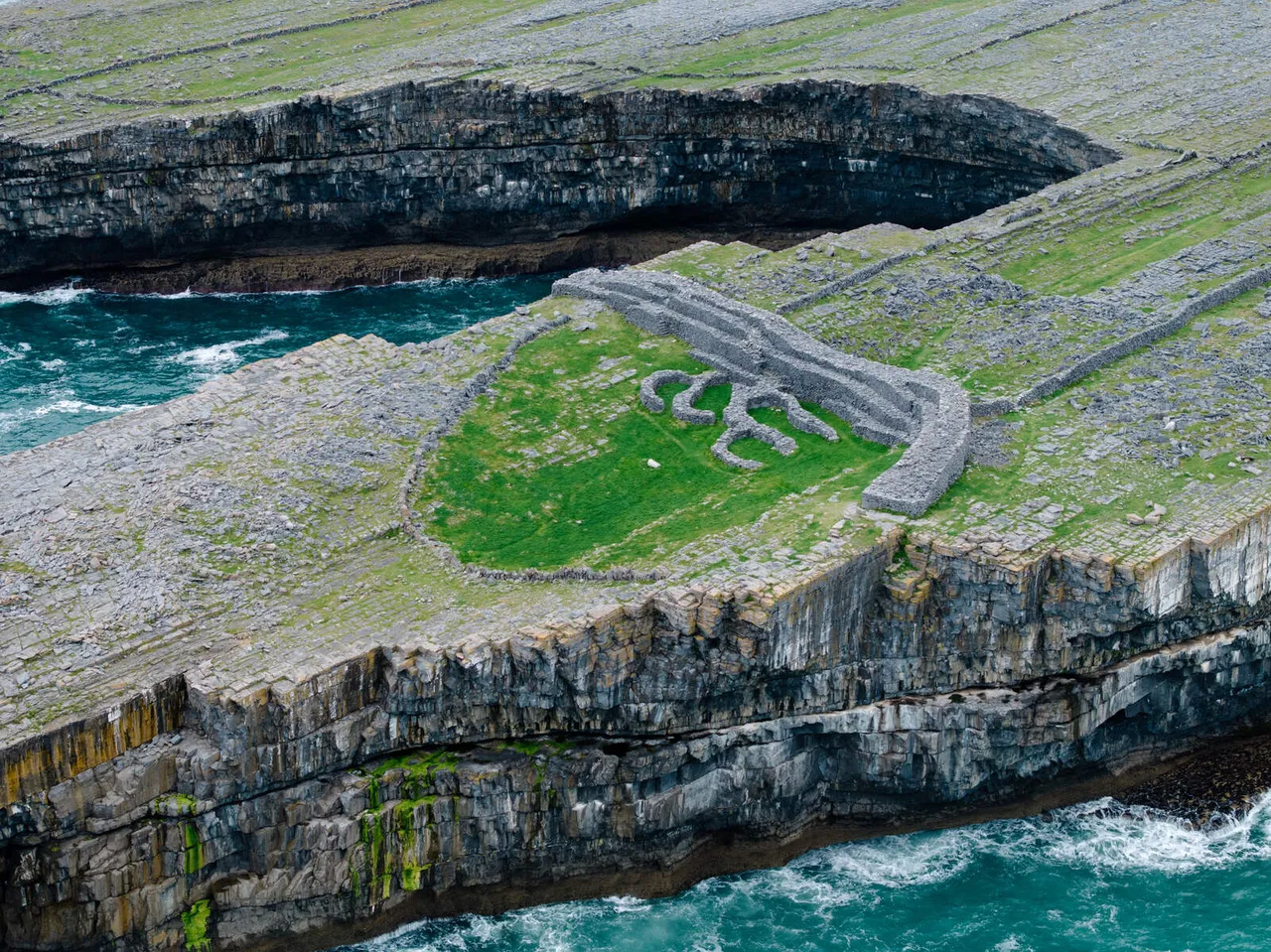
For a less crowded but equally atmospheric cliff-fort experience, seek out Dún Dúchathair on the southern coast, west of Killeany. This promontory fort, possibly named for the darker limestone in the area, was likely once the largest on Inis Mór. It features impressive terraced walls enclosing the remains of several clocháns (early stone dwelling huts) and offers a sense of solitude often missing at the more famous Dún Aonghasa.
Clochán na Carraige: Beehive Hut
Near Kilmurvey stands Clochán na Carraige, considered one of the finest preserved examples of an ancient Irish stone beehive hut. These structures, built using the dry-stone corbelling technique, predate Christian times. This particular clochán is noted for its unusual form – circular on the outside but rectangular within.
Nature's Drama: Cliffs, Pools, and Shores
Beyond the ancient stones, Inis Mór offers stunning natural features shaped by the relentless Atlantic.
The Worm Hole (Poll na bPéist): Nature's Rectangle
A geological marvel that has gained recent fame, the Worm Hole (Poll na bPéist – 'Hole of the Serpent' or 'Sea Monsters') is a near-perfect natural rectangular basin carved into the limestone wave-cut platform south of Dún Aonghasa. It fills and empties dramatically with the tide through subterranean channels, and waves often crash over the rim, creating a mesmerising spectacle. Its fame grew after hosting the Red Bull Cliff Diving World Series. Reaching it involves a walk of 10-15 minutes from the end of the road near Gort na gCapall village, crossing uneven, sometimes jagged rock – good footwear is essential. While some brave souls swim or dive here, the powerful currents, waves, and difficult exit (via a small rope ladder) make it potentially hazardous and suitable only for the very experienced and cautious.
Kilmurvey Beach: Blue Flag Beauty
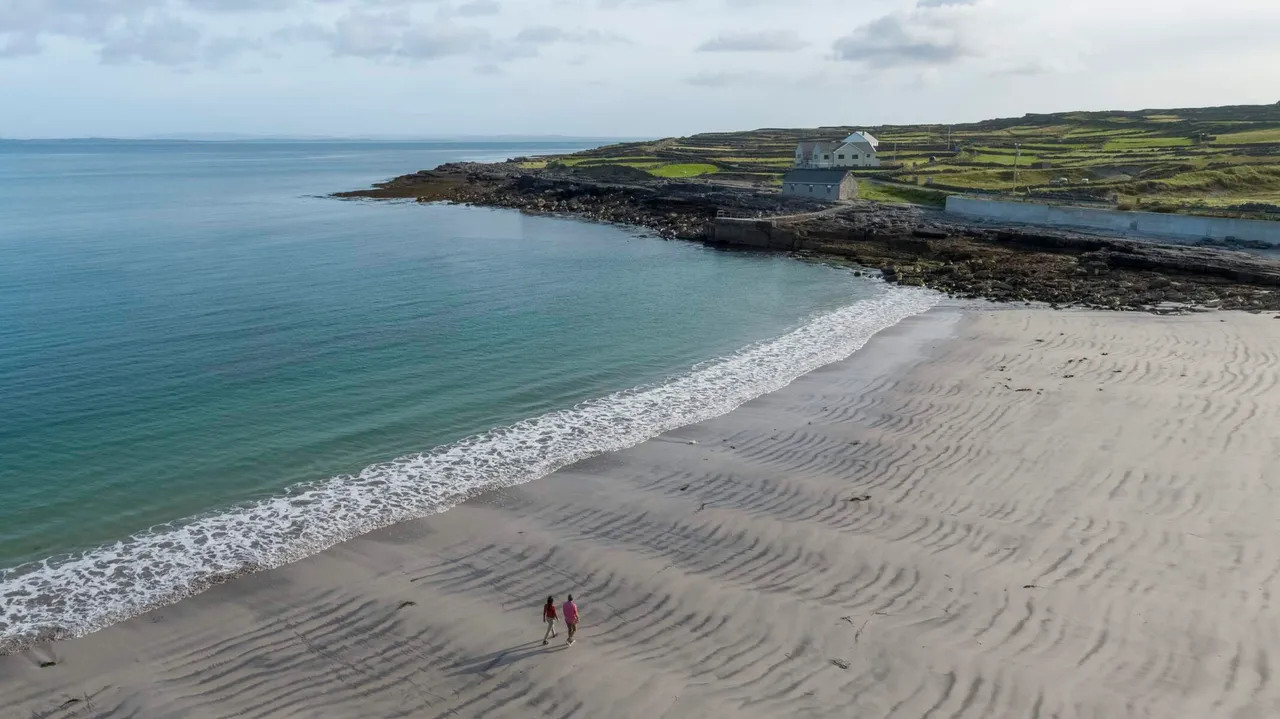
Nestled on the sheltered northern coast near the village of the same name, Kilmurvey Beach is Inis Mór's official Blue Flag beach. Its crescent of fine white sand meets calm, crystal-clear turquoise water, making it ideal for families and safe swimming. Lifeguards are on duty during the summer season. Located conveniently near the base of Dún Aonghasa, it's a perfect spot for a picnic or a refreshing dip after visiting the fort. There are toilet facilities available, and the nearby rocks offer opportunities for exploring rock pools.
Seal Spotting Sanctuary
A designated viewpoint along the coastal road, roughly a mile from Kilmurvey Beach, offers fantastic opportunities to observe the island's resident grey seal colony. The best time for viewing is at low tide, when numerous seals (often 5 to 20) haul themselves out to bask on the rocks. At high tide, they are much harder to spot, visible only as heads bobbing in the water. Picnic tables are provided at the site, making it a lovely spot for lunch with a view. The adjacent lake also attracts swans, ducks, and other birdlife.
Hidden Sands: Trá Mór & Frenchman's Beach
For those seeking quieter shores, Inis Mór has hidden gems. Trá Mór ('Big Beach'), located in the far eastern village of Iaraine, is arguably the most beautiful and secluded. Reached by walking north through sand dunes from the end of the paved road, its large dunes, pristine sand, and clear waters often feel completely deserted. Frenchman's Beach (Trá na bhFrancach) lies closer to Kilronan, in front of the Aran Camping & Glamping site. It's known as a good spot for swimming, snorkelling, and even scuba diving (the local dive school often uses it), as well as beachcombing and exploring rock pools.
Island Hub: Kilronan & Kilmurvey
Most services and activity on Inis Mór centre around two main villages.
- Kilronan Village: This is the island's main settlement and where the ferries arrive. It's the hub for renting bikes, joining pony and trap or minibus tours, and finding essential services. Here you'll find the island's main cluster of pubs (including Joe Watty's, The Bar, Tigh Joe Mac), restaurants (Pier House, Bayview), cafes, craft shops (like the Aran Sweater Market), and the Spar supermarket, which houses the island's only ATM. Kilronan also boasts a modern children's playground and basketball court.
- Kilmurvey Craft Village: Situated strategically near Kilmurvey Beach and the visitor centre for Dún Aonghasa, this smaller cluster offers welcome refreshment and retail opportunities. It's home to the picturesque thatched cottage café, Teach Nan Phaidi, renowned for its home baking, as well as other craft shops and potentially food options like the Man of Aran Fudge stand or the Aran Seafood Cafe food truck nearby.
Exploring Inis Meáin (Inishmaan): The Quiet Middle Island
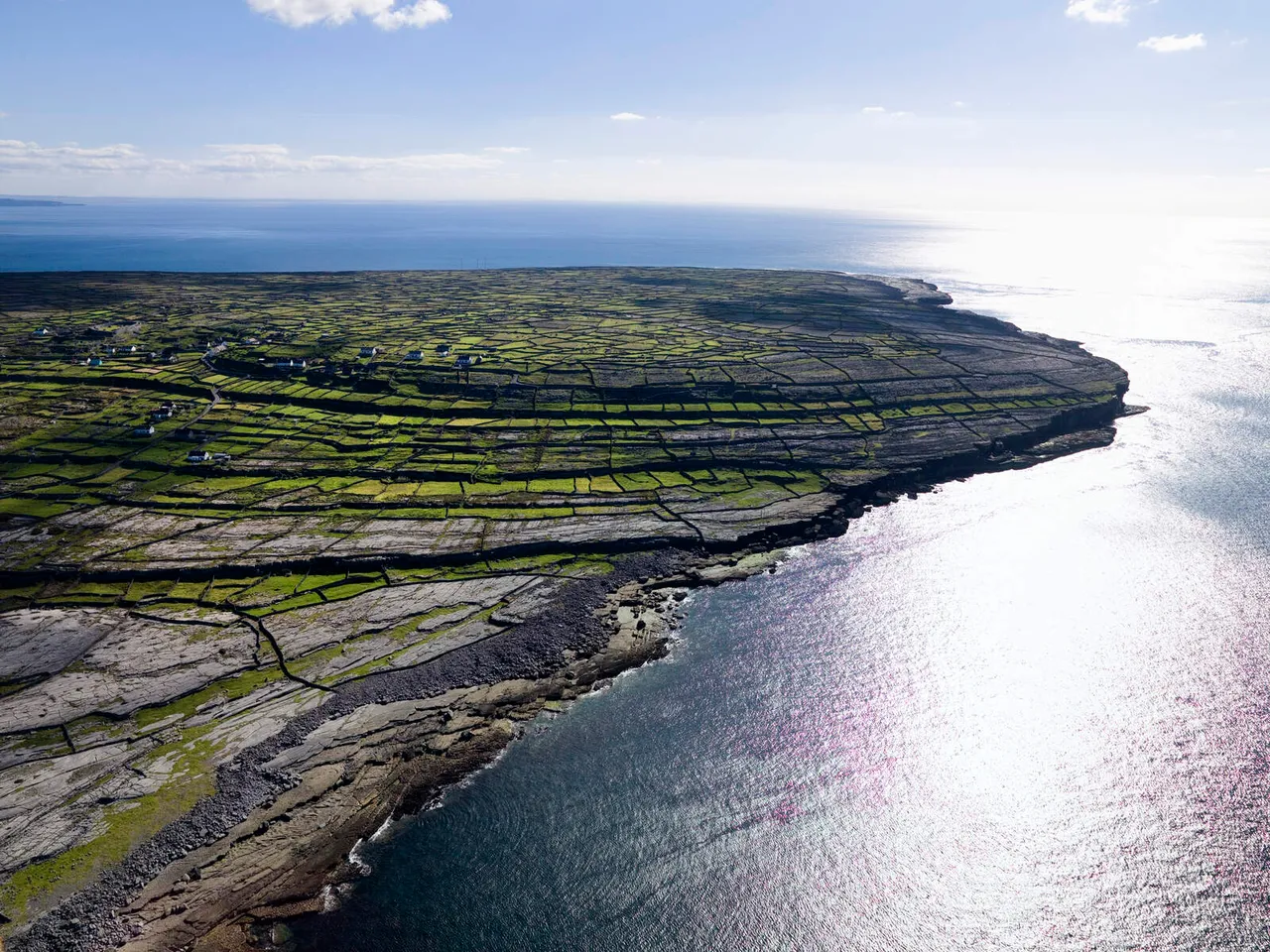
Inis Meáin, the middle island both geographically and in size, offers a profoundly different experience. With the smallest population (around 160-200 residents) and receiving the fewest visitors, it is a haven of tranquility and a stronghold of traditional Aran life. This is where the Gaelic heritage feels most potent, where the Irish language truly dominates daily conversation, and where the starkly beautiful landscape of limestone pavements, endless stone walls, and vibrant wildflowers seems untouched by time. Inis Meáin isn't about ticking off sights; it's about immersing yourself in a unique, contemplative atmosphere, stepping away from the modern world, and connecting with the island's ancient soul. The relative lack of tourist infrastructure here isn't a drawback; it's the key to its deeply authentic character.
Ways to Wander: Getting Around Inis Meáin
The island's compact size (roughly 5km by 3km) and quiet roads make it perfect for exploring slowly.
- Focus on Walking: Walking is perhaps the ideal way to experience Inis Meáin's subtle beauty and peacefulness. Several waymarked loop trails guide you through the landscape, taking in key sites and offering stunning views. Options include the official Inis Meain Way (8km) and local loops like Lúb Dún Chonchuir (8km, easy/moderate), Lúb Dún Fearbhaí (13km, moderate, covers high points), and Lúb Cill Cheannannach (10km, easy/moderate). Coastal paths provide dramatic sea views.
- Bicycle Hire: Cycling is possible, but options are more limited than on the other islands. One hire location is mentioned near the 'old pier', which is a significant walk (around 40 minutes) from the main ferry arrival point (the 'new pier'). It might be necessary to reserve bikes ahead by calling 099 73097, or even consider bringing your own bike on the ferry (check ferry company policy and fees). A leisurely cycle around the main sights might take 2-4 hours.
- Minibus Tours: For those who prefer not to walk or cycle, minibus tours are available, offering a relaxed way to see the island with local commentary. Brídín Tours is mentioned as an operator (contact 087 02482637). A private minibus can also meet arrivals at the airstrip.
Forts and Folklore: Historic Sites
Inis Meáin holds significant ancient sites, linking it to both pre-Christian times and enduring Irish legends.
Dún Chonchúir (Conor's Fort): The Oval Fort
Dominating the island's highest point, Dún Chonchúir is a large and impressive oval-shaped stone fort (cashel) dating back to pre-Christian times. Its commanding position offers panoramic views across the island's intricate network of stone walls and out to sea. The fort features substantial defences, including a very thick inner wall (over 8 metres wide in places) built in layers, and remnants of an outer wall. Though restored, its scale speaks to its former importance. The name may link to Conor, potentially a brother of the mythical Aengus associated with Inis Mór's great fort.
Dún Fearbhaí: The Rectangular Ruin
Located closer to the shore, Dún Fearbhaí is another stone fort, notable for its unusual, almost rectangular shape, contrasting with the more typical circular forts found on the islands. It's believed to date from the 4th century AD and lies on the route of the Lúb Dún Fearbhaí walking trail.
Leaba Dhiarmada agus Ghráinne (Diarmuid and Gráinne's Bed)
This collapsed wedge tomb connects Inis Meáin to one of Ireland's most famous romantic legends – the flight of the lovers Diarmuid and Gráinne. Pursued by the warrior Fionn mac Cumhaill, they were said to have rested in a different spot each night, with many megalithic sites across Ireland bearing their name. Its presence here weaves the island into the rich tapestry of Irish mythology.
Literary Landscapes: Synge's Island
Inis Meáin holds a special place in Irish literary history, thanks to its profound influence on playwright John Millington Synge.
Synge's Chair: A Writer's Viewpoint
On the wild, western cliffs of the island sits 'Synge's Chair' (Cathaoir Synge), a natural formation of limestone slabs creating a sheltered seat overlooking the Atlantic. This was the favoured spot of J.M. Synge during the summers he spent on Inis Meáin between 1898 and 1902. Here, he absorbed the island's atmosphere, listened to the islanders' stories (often in Irish, which he learned here), and found inspiration for works like Riders to the Sea and The Playboy of the Western World. The spot offers magnificent, uninterrupted views towards Inis Mór and the Connemara coast, and retains a powerful sense of quiet contemplation. It's accessible via a coastal path.
Teach Synge: A Glimpse into the Past
The actual cottage where Synge lodged during his influential stays has been carefully restored and opened as a museum, Teach Synge. This traditional 300-year-old house offers visitors insight into Synge's life, his work, and the island environment that shaped his writing. It provides context for understanding how this seemingly remote island played a key role in the Irish Literary Revival.
Threads of Tradition: Inis Meáin Knitting Company
The Aran sweater tradition is strongly represented on Inis Meáin through the internationally renowned Inis Meáin Knitting Company. Founded in 1976 by Tarlach de Blácam and Áine Ní Chonghaile, the company aimed to provide sustainable local employment while celebrating and reinventing the island's rich knitting heritage. They produce high-quality, sophisticated knitwear using luxurious natural yarns like cashmere, alpaca, linen, and silk, drawing inspiration from traditional Aran stitches but interpreting them in contemporary styles and colours. Their garments, bearing the distinctive logo of an upturned currach, are exported to high-end stores worldwide. Visitors can browse and purchase items, often at discounted prices, at the factory shop on the island. However, shop opening hours are limited, particularly outside the main season (March-September), so it's advisable to check ahead or email ([email protected]) or call (+353 99 73009) to enquire about visits or appointments.
Island Sustenance: Pubs and Provisions
Reflecting its quiet nature, Inis Meáin has limited, but characterful, options for food and drink.
- Teach Ósta: This is the heart of the island's social life – Teach Ósta is the only pub on Inis Meáin. Housed in a traditional building, possibly thatched, it offers a warm welcome with an open fire in cooler weather and outdoor seating for sunny days. Expect creamy pints of Guinness, a selection of whiskeys, and simple, satisfying bar food like toasties and pizzas, often served at specific lunch and evening times. It's the prime spot for experiencing traditional music sessions, which happen regularly in summer (sometimes impromptu singalongs occur year-round), and it's where the unique annual 'Cead' game culminates. A visit here is essential for soaking up the local atmosphere.
- Other Food/Drink: Options beyond the pub are few. The luxurious(https://inismeain.com/) offers high-end, island-sourced dining seasonally (reservations crucial). An Dún B\&B has a restaurant featuring home cooking. Tig Congaile B\&B is noted for local seafood and quiches. Caifé Synge provides basic beverages and snacks. For essentials, Siopa Ruaidhrí Beag is the island's grocery shop.
Exploring Inis Oírr (Inisheer): Charm of the East
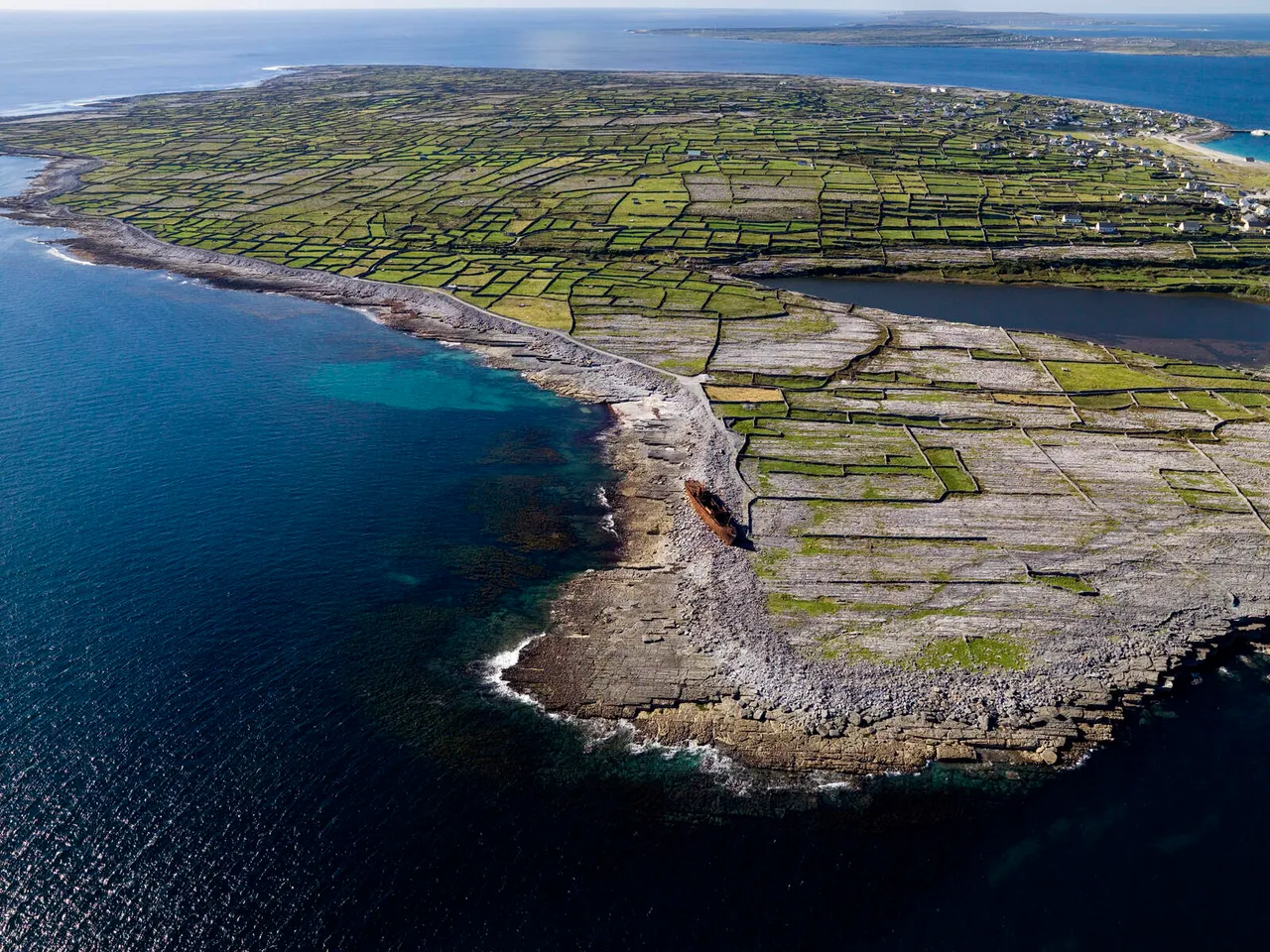
Inis Oírr, the easternmost and smallest of the Aran Islands, packs a remarkable amount of charm into its compact landscape. As the closest island to the mainland, particularly to the Doolin ferry port in County Clare, it often feels like the most immediately accessible of the trio. Home to around 300-350 people, it shares the characteristic Aran limestone terrain, closely resembling the nearby Burren, but is perhaps best known for its stunning, powder-soft sandy beach right by the harbour, its vibrant displays of wildflowers in season, and a captivating blend of history and folklore. It strikes a balance, offering a taste of authentic island life and key Aran experiences – ancient ruins, a famous shipwreck, lively pubs, local crafts – without the scale of Inis Mór or the deep quietude of Inis Meáin, making it particularly appealing for day-trippers and families.
Ways to Wander: Getting Around Inis Oírr
Its small size makes Inis Oírr incredibly easy to navigate.
- Compact & Walkable: Measuring less than 3km long and 2km wide, the entire island can comfortably be explored on foot. The main sights are relatively close to the pier and village area.
- Bicycle Hire: Renting a bike is a very popular and practical option.(https://www.rothai-inisoirr.com/) is located conveniently near the pier, offering a range of bikes including standard models, e-bikes, and options for children (child seats, buggies, tag-alongs). Helmets and maps are provided. With very few cars, cycling is generally safe and enjoyable, even for families.
- Pony and Trap Tours: As on Inis Mór, traditional pony and trap tours offer a guided, leisurely way to see the island's highlights and hear local stories.
- Wanderly Wagon Tours: A unique local option is the 'Wanderly Wagon' tour – a large, covered trailer pulled by a tractor, providing a fun and sheltered way to visit key locations like O'Brien's Castle and the Plassey Shipwreck.
- Walking Trails: The main waymarked trail is Lúb Ceathrú an Locha, a 10.5km loop walk that starts and finishes at the pier. It takes you past notable sites including An Loch Mór (the Big Lake) and the Plassey shipwreck.
Landmarks and Legends
Despite its size, Inis Oírr boasts a fascinating array of historical sites and iconic landmarks.
O'Brien's Castle (Dún Formna): A Norman Keep
Perched prominently on a hill overlooking the harbour and beach, the ruins of O'Brien's Castle are often the first major landmark visitors spot upon arrival. This 15th-century tower house (built c. 1400) was constructed by a branch of the powerful O'Brien clan within the earthworks of a much older ringfort, Dún Formna, which may date back to the Iron Age or earlier. The castle saw conflict, being captured by the O'Flaherty clan from Connemara around 1582, and later 'slighted' (partially demolished to remove its strategic value) by Cromwellian forces in 1652. The substantial ruins include parts of the rectangular keep, vaulted basement chambers, and evidence of a former great hall. A notable detail is a carved human face visible on the corbel of a bartizan (overhanging turret). The climb up the hill is rewarded with spectacular views across the island, Galway Bay, the Clare coast, and the Cliffs of Moher.
The Plassey Shipwreck: A Father Ted Icon
Instantly recognisable to fans of the comedy series Father Ted, the rusting hulk of the MV Plassey lies dramatically stranded on Finnis Rock on the island's eastern shore. Originally a WWII minesweeper (HMS Juliet), then a cargo vessel, the Plassey was carrying goods like whiskey and yarn from Kerry to Galway when it ran aground in a fierce storm on the night of 8th March 1960. In a remarkable display of bravery, the entire crew of eleven was rescued by the islanders using a Breeches Buoy system fired from the shore. Weeks later, another powerful storm lifted the vessel bodily and deposited it further up on the rocks, where it has remained ever since, gradually decaying but becoming Inis Oírr's most famous, albeit accidental, tourist attraction.
Guiding Light: Inis Oírr Lighthouse
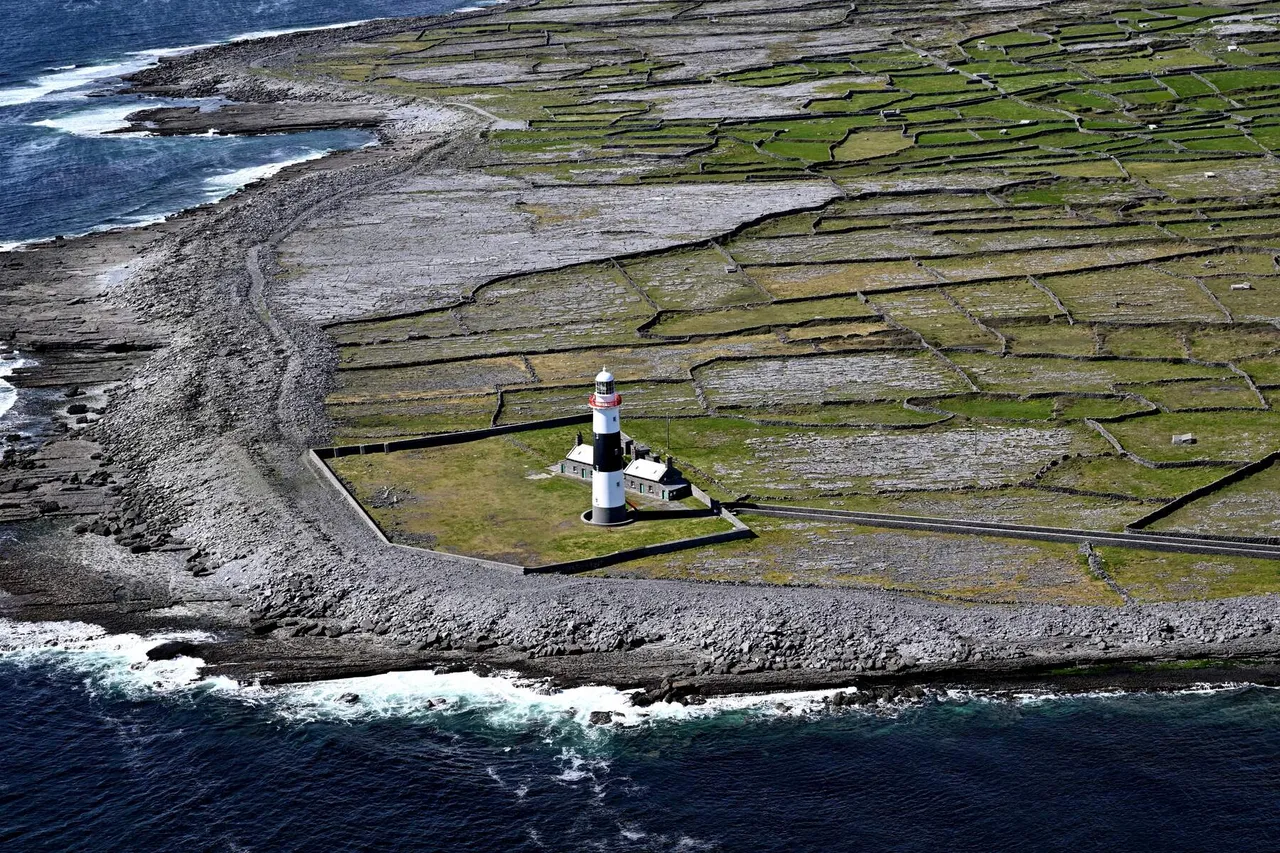
Standing sentinel at Fardurris Point on the island's southeastern tip is the active Inis Oírr Lighthouse. Built in 1857 along with its counterpart, Eeragh Lighthouse, to mark the hazardous approaches to Galway Bay, its tall, slender tower is distinctively painted with broad white and black bands. It marks the South Sound entrance and has a specific red light sector warning ships of the dangerous Finnis Rock (where the Plassey met its end). Automated since 1978, the lighthouse itself isn't usually open to visitors, but its striking form is a key feature of the island's coastline.
Teampall Chaomháin (St Cavan's Church): The Sunken Church
Dedicated to St Caomhán (or Kevin), Inis Oírr's patron saint, the ruins of this 10th-century church lie near the island's airstrip. Its fame comes from its picturesque location, partially submerged in the surrounding sand dunes. Over centuries, blowing sand has threatened to engulf the ruins completely, and it's a long-standing local tradition for islanders to gather annually (around the saint's feast day, June 14th) to dig out the church, keeping its walls visible. St Caomhán's grave, Leaba Chaomháin, is located nearby and is traditionally believed to possess healing powers. An open-air mass is held at the site on the feast day.
Cnoc Raithní: Bronze Age Burial Mound
Less visually dramatic but historically significant is Cnoc Raithní, a Bronze Age burial mound dating back to around 1500 BC. Uncovered by a storm in 1885, excavations revealed artefacts including a bronze pin and a vessel containing cremated human bones, confirming its ancient origins. It is now protected as a National Monument.
Island Shores: Trá Inis Oírr
The main beach on Inis Oírr (Trá Inis Oírr) is one of its most delightful features, conveniently located right beside the ferry pier. This beautiful stretch of powder-soft, white sand slopes gently into crystal-clear, azure water, offering stunning views across Galway Bay towards the mainland coast of Clare and Connemara. It boasts both Blue Flag and Green Coast awards for its cleanliness, water quality, and environmental standards, making it exceptionally safe and appealing for swimming and paddling. A lifeguard is typically on duty during the summer months. Its accessibility and safe conditions make it a favourite spot for families to relax, build sandcastles, and enjoy the sea after exploring the island.
Island Tastes and Crafts
For a small island, Inis Oírr offers a good selection of places to eat, drink, and find a unique souvenir.
- Pubs & Cafés: Several welcoming establishments cluster near the pier and beach area. Tigh Ned is renowned for its fresh seafood (lobster, crab claws, chowder) and has a lovely stone beer garden overlooking the bay. Tigh Ruairí is another pub, also operating as a B\&B, close to the beach, serving bar food and traditional meals. O'Flaherty's Bar, located within the Óstán Inis Oírr hotel, offers a full menu of Irish dishes and snacks. For lighter bites and home baking, the Aran Café and Tea Rooms (Teach an Tae) is a popular choice. Near O'Brien's Castle, The Seaweed Café provides soups, sandwiches, pizzas, and also incorporates a craft shop. You might also find Café Úna or the seasonal Crêpe van near the beach for quick treats.
- Crafts: The most distinctive local craft product is Man of Aran Fudge, made by the Póil family following a long tradition. Their shop is conveniently situated between the pier and the beach, offering a sweet taste of the island to take home. Other local crafts may be found in places like The Seaweed Café.
Island Adventures: Activities for Every Explorer
Beyond sightseeing, the Aran Islands offer a wealth of activities that allow you to engage directly with their unique environment and culture. These aren't just generic holiday pastimes; they are ways to connect with the very essence of what makes Aran special – the dramatic landscape, the surrounding sea, the living traditions, and the skills honed by island life over centuries.
On Two Wheels: Cycling the Aran Islands
Hiring a bicycle is perhaps the most popular and rewarding way to explore, especially on Inis Mór and Inis Oírr. It grants you the freedom to stop whenever a view catches your eye, to feel the Atlantic breeze, and to navigate the quiet lanes and boreens at your own pace. Bike hire is readily available near the piers on the two larger islands, offering everything from standard mountain bikes to highly recommended electric bikes (particularly helpful for Inis Mór's hills), tandems, and full family setups with kids' bikes and trailers. Even on Inis Meáin, though more limited, bike hire is possible. Cycling allows you to cover significant ground while remaining intimately connected to the sights, sounds, and scale of the island landscapes.
Walk This Way: Hiking Trails and Coastal Strolls
For those who prefer to explore on foot, the Aran Islands are a walker's paradise. Each island offers waymarked trails of varying lengths and difficulties, from the extensive 34km Inis Mór Way to the compact 8km Inis Meáin Way and 10.5km Inis Oírr Way. Detailed loop walks provide options for shorter excursions, taking in key historical sites and natural features. Walking allows for the closest appreciation of the unique flora sheltering in the limestone grykes, the intricate patterns of the stone walls, and the dramatic coastal scenery. Whether tackling a longer hike or enjoying a gentle stroll along a quiet lane or beach, walking offers a peaceful and profound connection with the islands' spirit. Remember sturdy footwear, especially if venturing off paved paths or exploring ruins.
Atlantic Dips: Swimming and Snorkelling Spots
On a fine day, the clear, turquoise waters surrounding the islands can be incredibly inviting. While the Atlantic is always refreshing (to put it mildly!), several spots offer relatively safe and beautiful locations for a swim or paddle. The Blue Flag beaches at Kilmurvey (Inis Mór) and Trá Inis Oírr are the most popular, being sheltered and lifeguarded in season. Quieter options like Frenchman's Beach or the secluded Trá Mór on Inis Mór offer lovely swimming too, with Frenchman's Beach also being good for snorkelling. The visually stunning Worm Hole is a unique bathing spot, but its potentially strong currents and difficult access mean it should only be considered by experienced and cautious swimmers aware of the risks. Note that swimming at Inis Meáin's main beach is generally discouraged due to strong currents.
Cast a Line: Fishing Opportunities
Given the islands' deep historical connection to the sea, it's no surprise that fishing remains part of the local fabric and an activity available to visitors. Shore angling is possible from various points around the islands, with reports of good catches. Fishing from the piers, particularly for mackerel and pollock when they are in season, can also be productive. For a more dedicated experience, boat trips offer the chance for deep-sea angling in the rich waters of Galway Bay. Local operators like Aran Sea Tours, based on Inis Mór, run chartered fishing trips targeting species such as pollack, mackerel, cod, and even the thrilling blue shark during the right season, often providing all the necessary gear.
Crafting Connections: Aran Sweaters and Local Arts
Taking home a piece of Aran craftsmanship is a wonderful way to remember your visit. The iconic Aran sweater (Geansaí Árainn) is the most famous example, a garment born of necessity, knitted with intricate patterns traditionally imbued with symbolism related to the sea and island life. You can find authentic sweaters and other knitwear at specialist shops like the Aran Sweater Market in Kilronan (Inis Mór), the factory shop of the Inis Meáin Knitting Company on Inis Meáin, and smaller outlets like An Túirne near Dún Aonghasa. Beyond knitwear, look out for other local crafts in shops around Kilronan and Kilmurvey, unique Celtic-design clothing and prints from Lia Arann on Inis Mór, or the delicious, traditionally made Man of Aran Fudge on Inis Oírr. Engaging with these crafts connects you directly to the skills and heritage of the islands.
Aran for All Ages: Family-Friendly Fun
The Aran Islands offer a surprisingly welcoming and engaging environment for families travelling with children, providing a refreshing alternative to more conventional holiday destinations. The magic lies in the simple, wholesome adventures the islands naturally afford, fostering a sense of freedom and discovery in a unique setting. It’s an opportunity for families to disconnect from screens and reconnect with each other and the natural world.
The islands feel inherently safe, particularly the smaller lanes away from the main ferry points, with minimal traffic compared to the mainland. This relative peace of mind allows children a degree of freedom to explore. Inis Oírr, being the smallest and most compact, is often highlighted as particularly suitable for those with younger children, as key attractions are within easy reach.
Beaches are a major draw. The beautiful, sandy stretches at Kilmurvey on Inis Mór and right by the pier on Inis Oírr are perfect for classic seaside fun – building sandcastles, paddling in the clear (if chilly!) water, and exploring rock pools teeming with tiny marine creatures. Both these main beaches are lifeguarded during the summer season, adding an extra layer of reassurance.
Getting around can be part of the adventure. Hiring bikes is a fantastic family activity, with options for child seats, trailers for toddlers, tag-along attachments for younger riders, and smaller bikes for independent children readily available on Inis Mór and Inis Oírr. The relatively flat coastal road on Inis Mór or the gentle terrain of Inis Oírr make for enjoyable family cycles. For a truly novel experience, a pony and trap ride is bound to delight children. Available on both Inis Mór and Inis Oírr, it offers a relaxed, traditional way to see the sights, often accompanied by stories from the local jarvey.
The islands' rich history can also capture young imaginations. Exploring the ancient stone forts like Dún Aonghasa (with appropriate caution near the cliffs) or the ruins of O'Brien's Castle (great for hide-and-seek, apparently) feels like stepping into a storybook. The very real and dramatic Plassey Shipwreck on Inis Oírr is a guaranteed point of interest, a tangible link to adventure and maritime history.
When little legs need a different kind of activity, both Inis Mór (in Kilronan village) and Inis Oírr boast excellent, modern playgrounds. The Inis Oírr playground, set picturesquely near the GAA pitch, is even listed among Ireland's best. These offer a great space for children to burn off energy and perhaps meet other visiting or local families.
Nature provides its own entertainment. Spotting the seals basking on the rocks near Kilmurvey on Inis Mór is always a treat. Birdwatching opportunities abound, and even simple activities like searching for colourful wildflowers or 'bug hunting' in the hedgerows (suggested for Inis Oírr) can be engaging ways to interact with the unique island environment.
Feeding the family is straightforward too. Many pubs, like Joe Watty's on Inis Mór, offer specific children's menus. Cafés provide welcome stops for snacks, drinks, and treats. Grabbing supplies from the Spar supermarket on Inis Mór for a picnic at the seal colony or on a beach is also a popular and easy option.
A Taste of Aran: Pubs, Cafés, and Local Flavours
The food and drink scene on the Aran Islands, while perhaps not extensive, is full of character and reflects the islands' unique identity. From cosy, traditional pubs echoing with music to charming cafés and restaurants showcasing fresh local produce, particularly seafood, there are rewarding culinary experiences to be found on each island. The offerings mirror the personality of each island: Inis Mór provides the most variety, Inis Meáin focuses on quality over quantity with its single pub and noted restaurant, and Inis Oírr offers a convenient cluster of welcoming spots near its harbour.
Island Pubs & Pints: Where to Find the Craic
The pub (teach tábhairne) remains a vital social hub on the Aran Islands, far more than just a place to get a drink. It’s where locals and visitors mingle, where the Irish language is often heard in natural conversation, and where the islands' rich musical traditions come alive. Expect welcoming atmospheres, often warmed by open fires on chilly days, and the lively spirit known as 'craic'.
- On Inis Mór: Kilronan village hosts several popular pubs. Joe Watty's is arguably the most famous, known for its excellent seafood, hearty pub grub, and lively traditional music sessions held seven nights a week during the summer season (and frequently at other times). The Bar and Tigh Joe Mac are other well-regarded options in Kilronan. Madigan's Bar within the Aran Islands Hotel also offers food and regular music.
- On Inis Meáin: The island famously has only one pub, Teach Ósta. This traditional, welcoming spot serves as the essential meeting point, offering pints, bar food, and regular traditional music sessions, making it a must-visit for anyone staying on or visiting the middle island.
- On Inis Oírr: Close to the pier, you'll find (https://tighned.com/), known for its focus on seafood and its pleasant beer garden with sea views. Tigh Ruairí is another option near the beach, and O'Flaherty's Bar is located in the island's hotel. Traditional music can often be found in these pubs during the summer months.
Café Culture & Cosy Bites
For daytime refreshment, light lunches, or home-baked treats, the islands offer several charming cafés.
- On Inis Mór: The standout is perhaps Teach Nan Phaidi in Kilmurvey, housed in a beautiful thatched cottage and famous for its baking, soups, and sandwiches. In Kilronan, options include the Pier House and Bayview Restaurant (which operate more like restaurants but may offer café services), the Aran Fisherman Restaurant for light bites, and newer spots like Minnie's Café (known for baking and açaí bowls) and the Man of Aran Craft & Coffee Shop. Don't miss the Aran Seafood Cafe food truck near Kilmurvey for delicious, casual seafood.
- On Inis Meáin: Options are very limited. Caifé Synge offers basic beverages and snacks.
- On Inis Oírr: The Aran Café and Tea Rooms (Teach an Tae) provides traditional baking and light lunches in a welcoming setting. The Seaweed Café, near O'Brien's Castle, offers a more modern take with sandwiches, pizzas, and light bites, alongside crafts. You might also find Café Úna or a seasonal Crêpe van near the beach.
Local Flavours: Seafood and Tradition
The taste of Aran is intrinsically linked to the sea. Freshly caught local seafood is the undisputed star of the islands' cuisine. Look out for delicious lobster and crab (often served simply as claws or in rolls), plump mussels, oysters, mackerel, salmon, and hearty seafood chowder, featured prominently on menus in pubs and restaurants across all three islands. Alongside the bounty of the sea, you'll find comforting traditional Irish dishes like rich stews, classic fish and chips, and satisfying plates served with locally grown potatoes and vegetables where possible. Don't forget to try the home baking – scones, cakes, and traditional brown bread are often exceptional.
Sweet Souvenirs: Man of Aran Fudge
For a unique edible souvenir, seek out Man of Aran Fudge on Inis Oírr. Located conveniently between the pier and the beach, this family-run business continues a long tradition of fudge making, offering a sweet reminder of your island visit.
The Enduring Magic of Aran
The Aran Islands are more than just a destination; they are an experience. They offer a rare opportunity to step into a landscape and culture shaped profoundly by the Atlantic, where the Irish language thrives, ancient history feels tangible, and a simpler, more deliberate pace of life persists. From the monumental cliffs and intricate stone walls of Inis Mór, through the contemplative tranquility and literary heritage of Inis Meáin, to the accessible charm and sandy shores of Inis Oírr, each island presents a unique facet of the Aran identity. Whether you explore by bicycle or on foot, listen to traditional music in a cosy pub, marvel at millennia-old forts, or simply sit and watch the Atlantic waves crash against the limestone shores, the islands leave an indelible mark. They are a testament to resilience, cultural continuity, and the enduring power of place. A journey here is a journey to the heart of Gaelic Ireland, an encounter with a timeless spirit that continues to captivate all who venture across the bay.
